Practical Development of a LINE Chatbot cooperating with a Laboratory Website using Amazon Web Services
1. Introduction
1.1 Background
A chatbot is defined as a conversational tool that seeks to understand user queries and responds automatically. IBM explains five types of chatbot (menu or button-based, rules-based, AI-powered, voice-based, and Generative AI-based) to choose user requirements [1].
Chatbots are increasingly utilized across various sectors, including marketing, education, healthcare, cultural heritage, and entertainment [2]. These conversational agents are designed to engage users and provide information on demand. One popular platform for chatbot deployment is LINE*1, a widely used messaging app with a global user base. Businesses, local governments, and educational institutions leverage LINE's chatbot functionalities to enhance communication and engagement.
1.2 Needs Analysis Process and Findings
Faculty members at our university hold a 1 on 1 meeting with each student once in a quarter throughout the academic year. The purpose of meetings is to build a relationship of trust between the university and its students, based on mutual respect, and to support students in their academic journey toward graduation.
Through the meetings, we conducted interviews to identify specific difficulties faced by students. As a result, we discovered that students expressed challenges in accessing detailed and up-to-date information about faculty research projects. Although our current website [3] is available, it lacks the depth and detail necessary to effectively showcase the breadth of ongoing research. Specifically, students highlighted the need for:
- ・An interactive and user-friendly interface for accessing research information.
- ・Features that enhance engagement, such as quizzes and tailored content.
- ・Integration with a comprehensive website dedicated to presenting faculty research activities, such as laboratory websites.
1.3 Our Contributions
We chose LINE due to its interactive capabilities and popularity among students. We believe that the LINE chatbot can bridge the communication gap between the university and students, fostering greater collaboration and understanding.
We developed our LINE chatbot using Amazon Web Services (AWS), a leading cloud computing platform. While the technical implementation of the chatbot system is important, this paper focuses on the practical insights and experiences gained during the development process. We share the challenges encountered, the strategies employed to overcome them, and the effective integration methods discovered. This practice-oriented approach aims to provide valuable knowledge that can be generalized and applied by other developers working on similar systems, as well as by practitioners in other fields exploring the use of chatbots and cloud technologies.
Specifically, this paper details:
- ・Practical challenges encountered during the integration of the LINE Messaging API with AWS services, including specific configurations and workarounds identified through hands-on experience.
- ・Iterative adjustments made to the chatbot's functionality based on user feedback, with discussions on how real-world usage informed design decisions and led to usability improvements.
- ・Generalizable strategies for developing and deploying chatbots in educational and public service contexts, including insights into effective communication strategies, content design, and user engagement techniques.
By focusing on the practical aspects of our development process, we aim to contribute to the body of knowledge on chatbot development and deployment. Our goal is to provide valuable, real-world insights that go beyond technical details and offer concrete examples of effective solutions.
1.4 Organization
The remainder of this paper is organized as follows. Section 2 provides an overview of related research. Section 3 introduces the key technologies employed in this study. Section 4 outlines the LINE chatbot developed in this study. Section 5 explains our laboratory website. Section 6 describes the development process for each function of the LINE chatbot. Section 7 presents the evaluation results and discusses their implications. Finally, Section 8 summarizes our findings and outlines future work.
1.5 Guiding the Reader through Our Study
In this paper, we position ourselves as guides to help readers understand the full scope of our study. Our aim is not only to describe technical implementations but also to offer a clear and structured presentation of the research process. We carefully explain the motivation and background that led to the development of the LINE chatbot system, followed by a detailed account of the system's functionalities, development methodology, and evaluation results.
Throughout the paper, each section is organized to logically build on the previous one, enabling readers to follow the flow of the study from start to finish. Key insights and challenges are highlighted to provide practical knowledge for readers planning to develop similar systems. Limitations and areas for future work are also clearly stated to ensure transparency and encourage further improvement.
By maintaining clarity and cohesion across sections, we strive to provide a comprehensive understanding of our chatbot system and its educational relevance. We hope that readers from both academic and practical backgrounds will find this paper informative, applicable, and easy to navigate.
2. Related Research
This section highlights previous works on chatbots, emphasizing their architectural designs and applications. However, instead of focusing solely on technical comparisons, this paper discusses practical considerations and lessons learned during the integration of LINE chatbots with AWS services. These insights aim to inform practitioners interested in deploying similar systems, especially in educational contexts, where such integration enhances communication and user engagement.
2.1 Chatbot Designs and Applications
Lokman and Ameedeen [4] conducted a comprehensive technical review of five modern chatbot systems: DeepProbe, AliMe, SuperAgent, MILABOT, and RubyStar. Their analysis covered architectural designs, including knowledge domains, response generation methods, and text processing techniques.
Adamopoulou and Moussiades [5] provided a historical and technical overview of chatbot technology, highlighting its evolution from simple rule-based systems like ELIZA to modern AI-powered conversational agents.
Luo et al. [6] researched state-of-the-art chatbot designs and applications. They also reviewed the usability and applications of chatbots for various business sectors.
2.2 Chatbots in Disaster Management and Educational Support
In the context of disaster management, where timely access to accurate information is important, LINE chatbots have emerged as a valuable tool. Hangyo et al. [7] demonstrated the potential of chatbots in disaster management by developing a system to disseminate critical information during emergencies. Their work illustrates the importance of designing chatbots that prioritize accuracy and reliability.
Noguchi et al. [8] highlighted the effectiveness of LINE chatbots in supporting educational institutions during the COVID-19 pandemic. They demonstrated the efficacy of LINE chatbots in providing timely support to students and faculty by addressing queries related to online learning platforms and tools.
Suzuki et al. [9] investigated the use of LINE chatbots to enhance student engagement during lectures by encouraging questions and facilitating interaction. Their findings highlight the potential of chatbots to create a more interactive and engaging learning environment.
Heryandi [10] developed a chatbot that allows parents to conveniently access their children's attendance records and grades.
2.3 Security in Chatbot Systems
Ensuring the security of chatbot systems is critical, as they often handle sensitive user data and provide interactive access to backend systems. The chatbot systems are susceptible to denial-of-service (DoS) attacks [11], which aim to disrupt service availability by overwhelming the system with traffic. The proliferation of distributed denial-of-service (DDoS) attacks, which exploit compromised IoT devices to amplify the attack's impact, has further heightened this threat [12].
With the widespread adoption of cloud computing since 2010, mitigating DDoS attacks in cloud environments has become important. Darwish et al. [13] proposed a comprehensive framework for DDoS mitigation tailored to different cloud service models (IaaS, PaaS, SaaS). Somani et al. [14] conducted a survey of DDoS attacks in cloud environments, emphasizing the effectiveness of autoscaling and defense-in-depth strategies. Rajan [15] focused on the emerging serverless architecture known as function-as-a-service (FaaS), with a particular emphasis on AWS Lambda.
2.4 Insights and Contributions to Our Study
The reviewed studies provide several key insights that have shaped the development of our LINE chatbot system:
- ・Chatbots can effectively bridge communication gaps between students and faculty members in education.
- ・Robust security measure, such as serverless architecture, is essential for reliable chatbot deployment.
By incorporating these insights, our study builds on existing knowledge to develop a practical and secure chatbot system tailored to the needs of educational institutions.
3. Cloud Computing
3.1 Amazon Web Services (AWS)
Amazon Web Services (AWS) is the world's leading cloud computing provider, offering a wide range of services such as computing power, storage, and machine learning. Unlike traditional on-premises models, AWS provides a scalable and cost-effective solution where users can access resources on demand [16].
AWS's extensive portfolio of over two hundred services caters to the diverse needs of startups, enterprises, and government agencies worldwide. Despite competition from other major cloud providers like Google Cloud Platform (GCP) [17] and Microsoft Azure [18], AWS holds the largest global market share, solidifying its dominance in the cloud computing market.
3.2 AWS Services Applied in This Study
This research applies four key AWS services for the development and deployment of the LINE chatbot:
- ・Amazon Simple Storage Service (S3): Highly scalable object storage service renowned for its durability, availability, and security. S3 is employed to store chatbot data, including conversation logs.
- ・Amazon API Gateway: Fully managed service that simplifies the creation, deployment, and management of web APIs. API Gateway is used to handle incoming requests from the LINE platform and route them to the appropriate Lambda functions for processing.
- ・AWS Lambda: Serverless computer service that allows developers to run code without provisioning or managing servers. Lambda functions are triggered by events, making them ideal for handling chatbot interactions in real time.
- ・Amazon DynamoDB: Fully managed NoSQL database service that delivers high performance and scalability. DynamoDB is utilized to store and retrieve chatbot data efficiently, ensuring a seamless user experience.
- ・Amazon CloudFront: Contents Delivery Network (CDN) service designed to reduce latency and improve content availability compared with traditional hosting solutions that rely on Linux servers running Apache*2 or nginx*3. It achieves this by catching and distributing content through numerous edge locations located worldwide, thereby minimizing the physical distance between the server and end-users.
While we utilized several AWS services, including S3, Lambda, API Gateway, and DynamoDB, the focus of this paper is the practical challenges encountered during their integration. For example, managing API endpoints with the LINE Messaging API [19] posed unexpected difficulties, which we resolved through specific API configurations. Such details provide valuable lessons for practitioners aiming to implement serverless architectures in chatbot development.
4. LINE Chatbot Cooperating with a Laboratory Website
4.1 Definition of Our Chatbot
In this study, we define our chatbot as a conversational tool designed to provide students with an interactive and user-friendly interface for accessing research information.
Our chatbot specifically targets the educational domain, catering to students who require up-to-date and detailed research information of faculty members. The primary scenarios include:
- ・Research Accessibility: Providing a centralized platform for accessing faculty members and students research projects.
- ・Interactive Learning: Enhancing student engagement through quizzes.
- ・Feedback Collection: Offering an intuitive mechanism for users to share feedback and improve the system iteratively.
These features are determined from the needs analysis shown in Section 1. The subsequent subsections provide details of the chatbot's architecture and features.
4.2 Overview
We developed a LINE chatbot system [20] integrated with a laboratory website using AWS services. Figure 1 illustrates the system architecture. We linked the LINE platform and AWS services using the LINE Messaging API [19]. The serverless architecture eliminates the need for individual server maintenance, enhancing the system's resilience against DDoS attacks.

The LINE chatbot operates according to the following workflow:
- (1)The chatbot is promoted through university events, official social media channels, and QR codes printed on posters and flyers distributed on campus.
- (2)Users add our official LINE account as a friend.
- (3)Upon receiving a message from users, the LINE server transmits a request to the API Gateway endpoint. Lambda then processes the request and generates a response message.
- (4)The response message created by Lambda is relayed to the LINE server via the LINE Messaging API and subsequently displayed on users' chat screen within our official LINE account.
Furthermore, Lambda interacts with DynamoDB to store user feedback, as detailed in subsequent subsections.
4.3 Features of Our Chatbot
We conducted the needs analysis shown in Section 1 and prioritized the features which our chatbot should have. As a result, the developed LINE chatbot incorporates four key features: research introduction, quiz, external link to a laboratory website, and user evaluation. Each function is explained as follows.
4.3.1 Research Introduction
The research introduction function provides an overview of the laboratory's research activities, including individual student projects. Users can access this information by sending the message “Research Content” and then selecting from the following options:
- ・Cloud Computing
- ・Cybersecurity
- ・Cryptography
Figure 2 illustrates the chatbot interface after the “Research Content” message is sent.
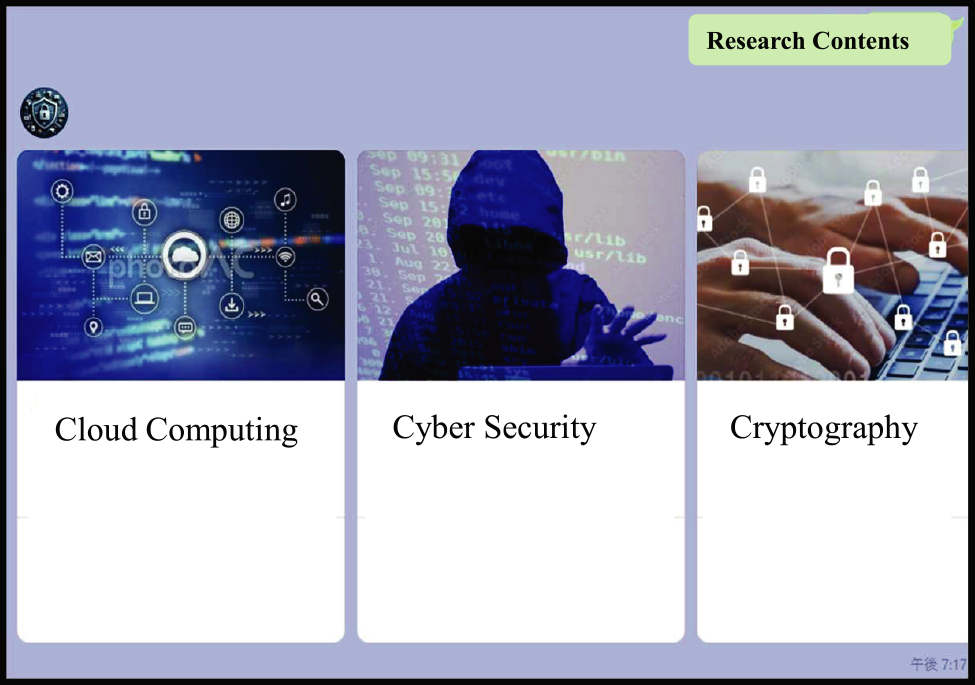
4.3.2 Quiz
The quiz function presents users with a series of 10 multiple-choice questions on topics related to cloud computing, cybersecurity, and cryptography. Figure 3 illustrates quiz function. Users initiate the quiz by sending the message “Quiz.” Each question is accompanied by an answer and explanation, which are revealed after users submit their response. This feature not only assesses users' knowledge but also reinforces their understanding of these domains.
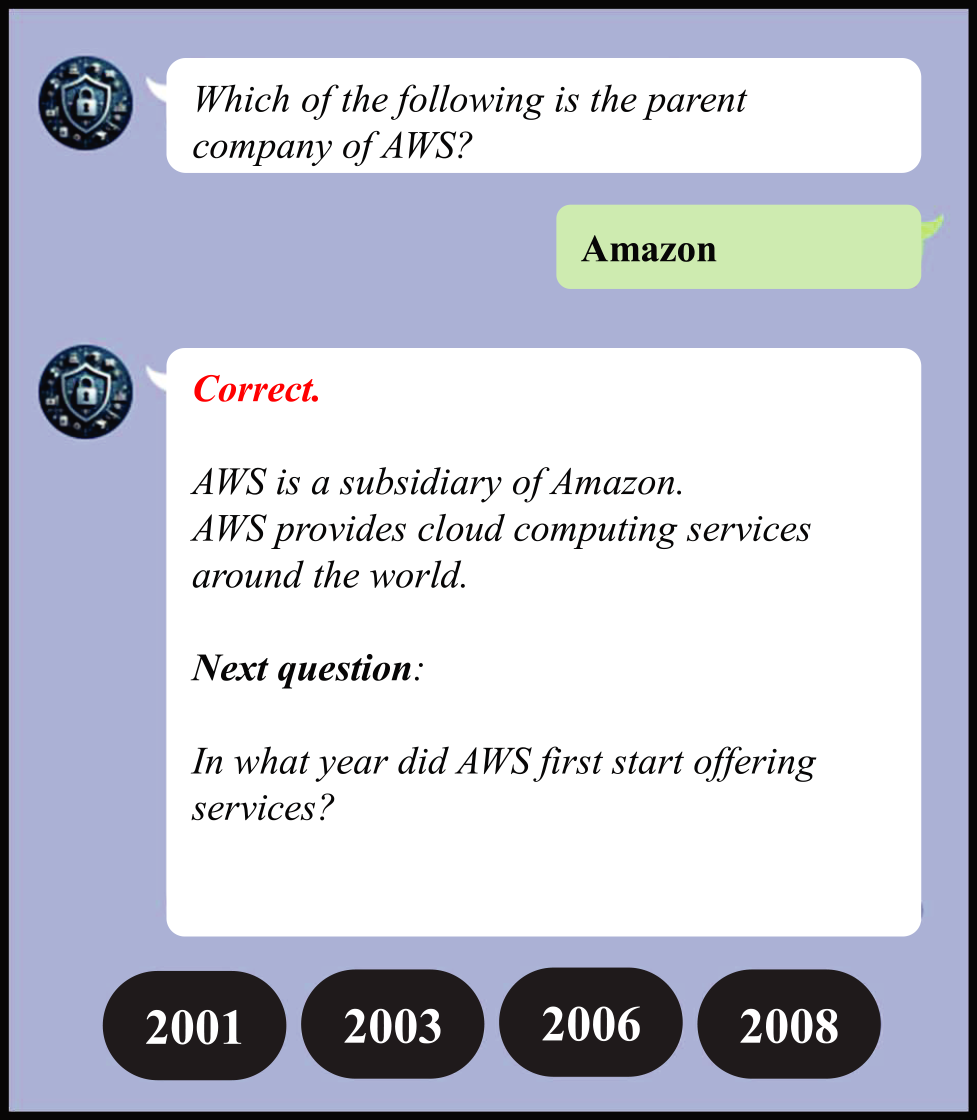
4.3.3 External Link
The external link function provides a direct link to our laboratory website which allows users to access more detailed information about our laboratory's research activities. The details of our laboratory website are explained in Section 5.
4.3.4 User Evaluation
The user evaluation function allows users to provide feedback by sending a message prefixed with “Evaluation:”. Figure 4 illustrates user feedback. This message is then stored in DynamoDB for subsequent analysis.
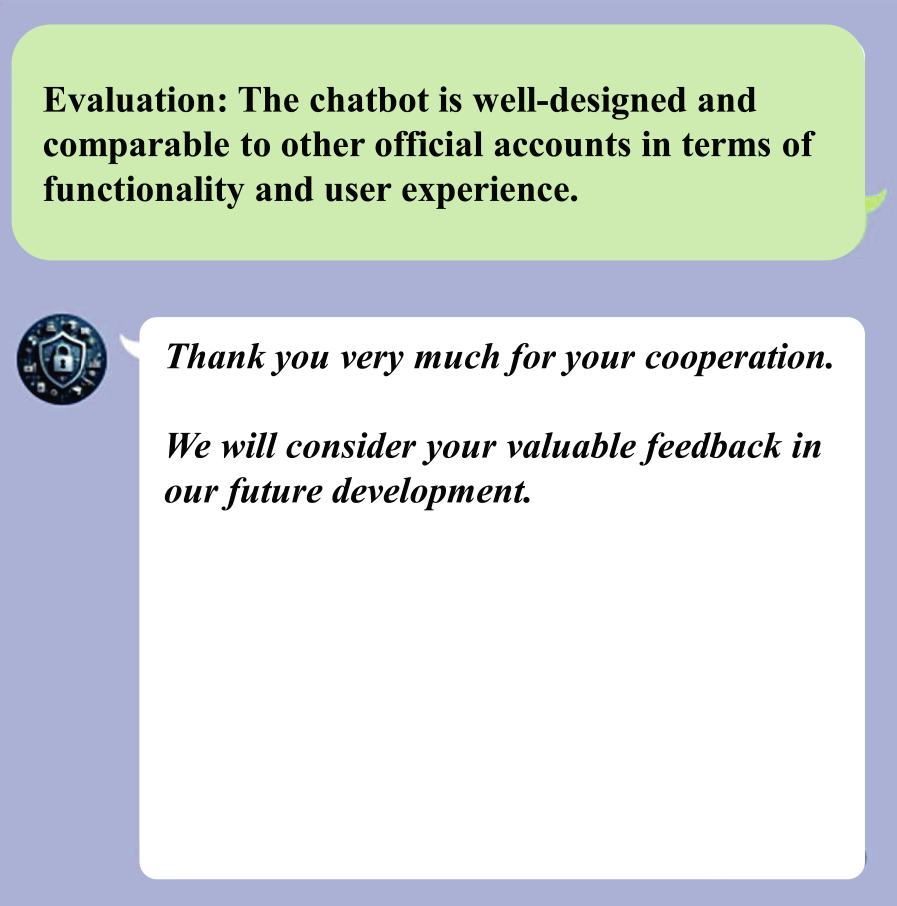
4.4 State Transition of Our Chatbot
The operational flow of our chatbot system is depicted in the state transition diagram shown in Figure 5. This diagram outlines the key states and transitions that characterize user interactions with the chatbot, offering a clear overview of its functionality.
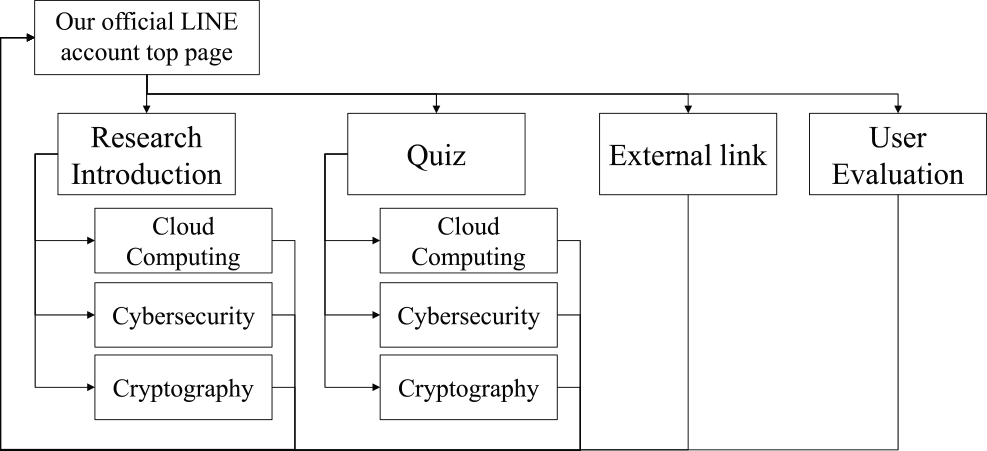
4.4.1 Key States and Transitions
The chatbot system comprises the following states and transitions:
- ・Initial State: The user initiates interaction by accessing the chatbot through our official LINE account's top page. Users can select a feature by sending the message such as “Research Content”, “Quiz”, “External Link”, or “Evaluation:”. Based on the user's input, the chatbot responds with the appropriate information or action.
- ・Research Introduction: Displays details about the laboratory's research areas, including cryptography, cybersecurity, and cloud computing.
- ・Quiz: Starts an interactive quiz session on topics related to the laboratory's research.
- ・External Link: Provides a direct link to the laboratory's website for more detailed information.
- ・User Evaluation: Enables users to submit feedback on their chatbot experience.
- ・Sub-feature States: Depending on the user's selection, the chatbot transitions to specific sub-features. For example:
– Selecting Research Introduction transitions to submenus for topics such as cryptography, cybersecurity, and cloud computing. Users can select one of these topics to view detailed information.
– Selecting Quiz transitions to submenus for topics such as cryptography, cybersecurity, and cloud computing. Users can choose a topic to participate in a series of multiple-choice questions.
4.4.2 Typical Interaction Flow
A typical interaction flow proceeds as follows:
- (1)The user accesses the chatbot and selects a feature by sending a message, such as “Research Content.”
- (2)The chatbot transitions to a Sub-feature State and displays a list of research topics.
- (3)The user selects a specific topic (e.g., Cryptography), prompting the chatbot to provide detailed information about that topic.
- (4)If the user chooses the quiz feature, the chatbot transitions to the quiz state and presents a series of questions.
- (5)At any point, the user can end the session with the chatbot.
5. Laboratory Website
The laboratory website was designed to be a comprehensive resource for research activities of faculty members. We experimented with different website structures―such as a single-page layout, hierarchical menus, and categorized sections based on research themes―before finalizing the current design. This iterative process helped us determine the most intuitive and informative structure for presenting research content. These insights are valuable for developers and educators designing similar educational platforms.
The laboratory website provides comprehensive information about faculty research activities to students. It can be accessed directly via URL or through the chatbot's external link function. Figure 6 shows the top page of laboratory website. The website offers detailed content on the following research areas:
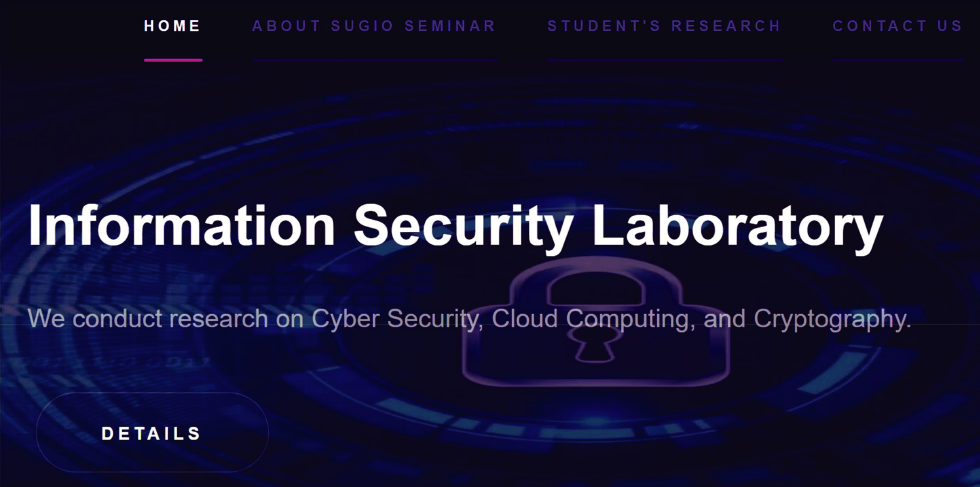
- ・Cloud Computing
- ・Cybersecurity
- ・Cryptography
- ・Others
For more details, users can access each content by choosing the item shown in Figure 7.
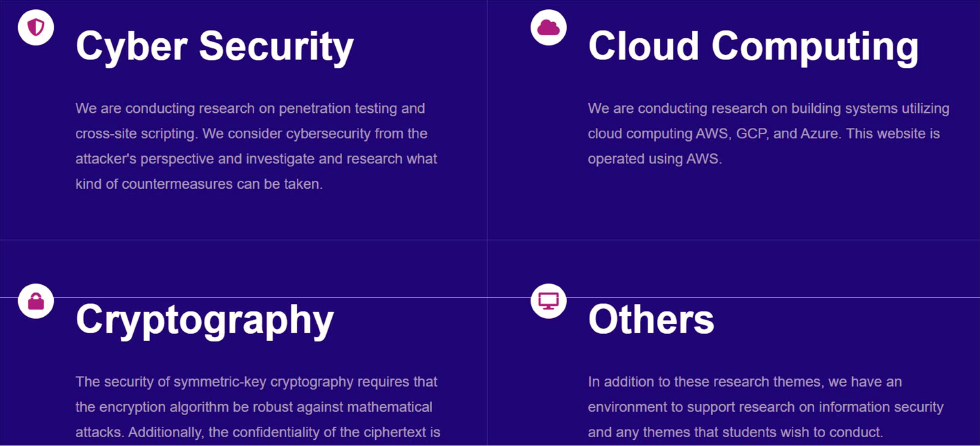
6. Development for the LINE Chatbot
This section details the development process of our LINE chatbot, focusing on the practical insights and challenges encountered. While we describe the technical implementation, we emphasize the practice element, highlighting the real-world experiences and lessons learned that can be generalized for broader application.
6.1 Functionalities and User-Centric Design
The chatbot incorporates several key functions: research introduction, quiz modules, external link access, and user evaluation capabilities. Each function was designed with practical considerations and user needs in mind. For example, the research introduction feature provides concise and engaging summaries of ongoing projects, catering to users with varying levels of technical expertise.
Initially, the user evaluation feature suffered from low engagement. To address this, we iteratively adjusted the design based on user feedback by referring Agile Software Development Process [21]. This involved simplifying the feedback mechanism and making the interaction more intuitive. This experience highlights a key practice: actively incorporating user feedback to iteratively improve design and functionality. This approach is crucial for ensuring that the system meets the real-world needs of its users. The details of our Agile Software Development Process are explained in the following subsection.
6.2 Development Timeline and Agile Process Details
The chatbot was developed from July to October 2023, using an Agile Software Development Process [21]. We adopted two-week sprints, allowing the team to iteratively plan, implement, and review system features based on user feedback.
The development team consisted of the following roles:
- ・Project Leader: Oversaw overall development and coordinated between technical and educational aspects.
- ・Frontend Developer: Designed and tested user-facing chatbot interfaces and message flows.
- ・Backend Developer: Implemented AWS Lambda functions and integrated LINE Messaging API.
- ・Content Designer: Created research content summaries, quiz questions, and chatbot messages.
- ・Evaluator: Collected and analyzed user feedback, and proposed improvements for the next sprint.
Each sprint began with a planning meeting to identify goals and tasks. Midway through each sprint, we conducted informal testing with students to validate usability. At the end of each sprint, feedback was reviewed, and necessary adjustments were made. This cycle ensured that development remained user-centered and responsive to emerging issues.
This structured yet flexible approach enabled efficient progress while maintaining a strong focus on user experience and educational relevance.
6.3 Serverless Architecture
6.3.1. Importance of DDoS Mitigation
Although the system did not experience any actual DDoS attacks during the study period, we considered DDoS mitigation to be an important design consideration from the outset. This decision was based on several factors.
First, the LINE Messaging API, which serves as the primary interface between users and the system, is a publicly exposed endpoint and could potentially be targeted by malicious traffic. Second, educational systems must remain reliably accessible to students, especially when providing essential research content. Even short periods of downtime could disrupt learning and reduce the system's perceived reliability.
By adopting a serverless architecture using AWS services such as API Gateway and Lambda, we were able to take advantage of automatic scaling and load distribution. This architecture inherently improves resilience to traffic surges and can mitigate the impact of potential DDoS attempts. In this way, DDoS protection was proactively integrated into the system architecture as part of a broader effort to ensure stable, uninterrupted service for educational use.
6.3.2 Benefits and Challenges
We adopted serverless architecture using AWS services such as Lambda, API Gateway, and DynamoDB. This decision was driven by the desire to minimize maintenance overhead and enhance system resilience. However, integrating the LINE Messaging API with AWS serverless architecture presented unexpected challenges. We initially struggled with configuring the API Gateway to correctly handle webhook requests from LINE. Through trial and error, we discovered specific configuration settings and workarounds that ensured seamless communication between the two platforms by referring to webhook errors explained in LINE Developers site*4. This experience emphasizes the importance of practical experimentation and documentation when integrating disparate technologies.
The serverless approach offered several benefits:
- ・Reduced maintenance workload: Eliminating the need for server management freed up valuable time and resources.
- ・Improved scalability: The serverless architecture automatically scales to handle fluctuations in user demand.
- ・Enhanced resilience against DDoS attacks: Serverless platforms are inherently more resistant to DDoS attacks due to their distributed nature.
This experience demonstrates that a serverless architecture can be a viable and advantageous solution for chatbot development, particularly for applications requiring scalability and resilience.
6.4 LINE Messaging API Integration: A Practical Guide
Integrating the LINE Messaging API with AWS Lambda required careful configuration. We documented the key steps involved, including:
- (1)Enabling the Messaging API in the LINE Developers console and obtaining a channel access token. (Figure 8)
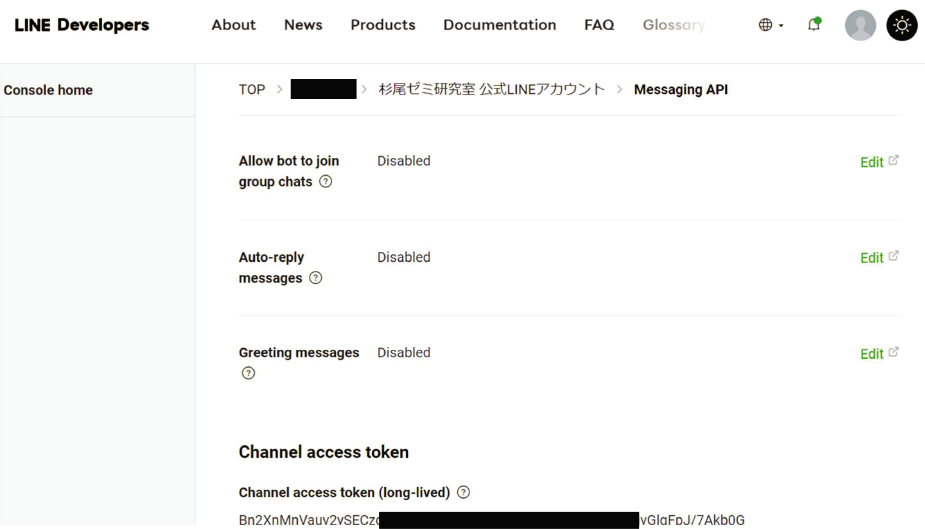
Fig. 8 Messaging API. - (2)Embedding the access token within the Lambda function's source code. (Figure 9)
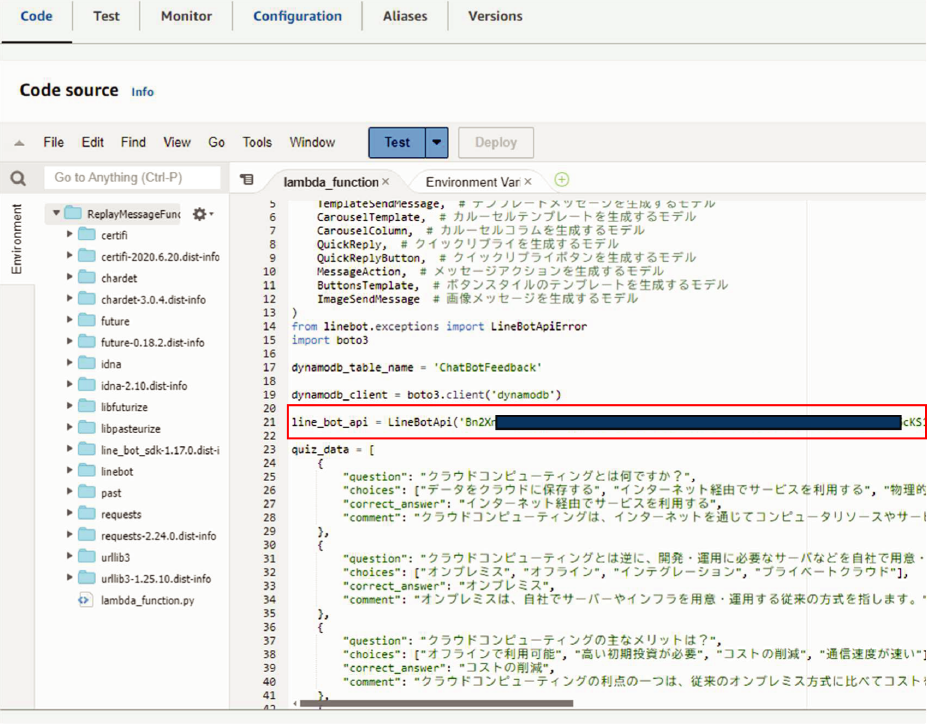
Fig. 9 Embedding the access token within the Lambda function. - (3)Creating an API Gateway endpoint to connect with the LINE Messaging API. (Figure 10)
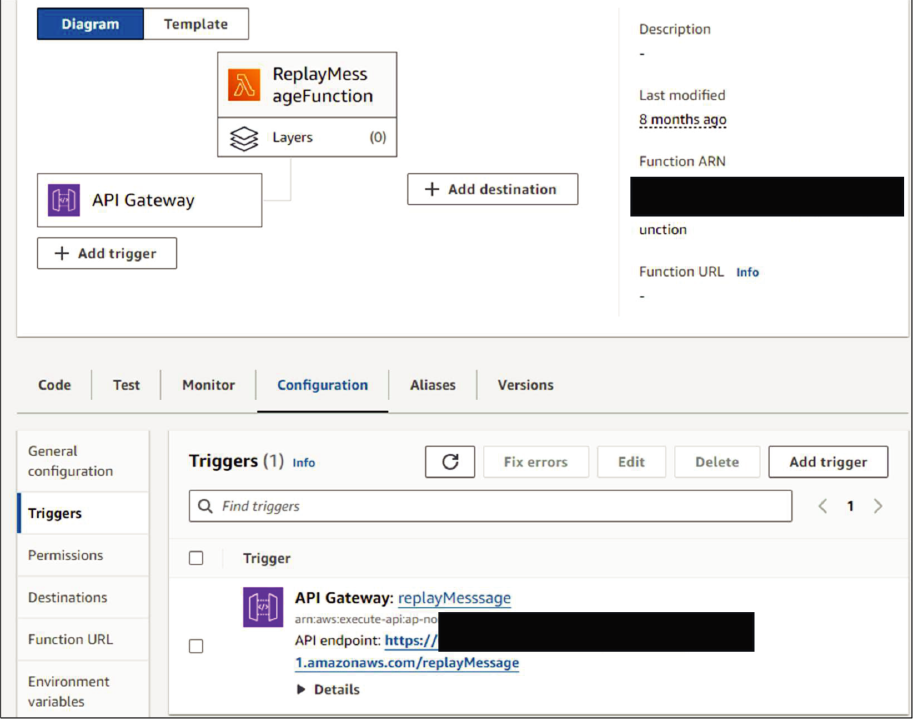
Fig. 10 Creating an API gateway endpoint. - (4)Configuring the Webhook URL in the LINE official account settings to point to the API Gateway endpoint. (Figure 11)
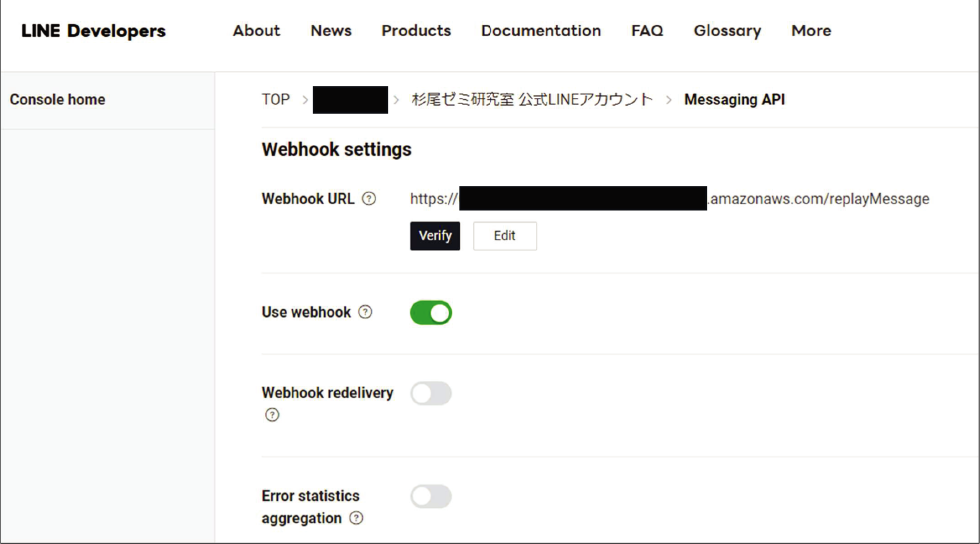
Fig. 11 LINE messaging API (Webhook).
This detailed documentation provides a practical guide for other developers seeking to integrate the LINE Messaging API with AWS services. By sharing our specific configuration settings and the challenges we face, we aim to help others avoid potential pitfalls and streamline their development process.
6.5 Implementation of Core Functionalities: Practical Considerations
6.5.1 Research Introduction
We initially presented the same descriptions as our laboratory website in a prototype. However, it was difficult for students to read all the research contents using our chatbot. They preferred concise summaries about research introductions. This led us to revise our approach and prioritize brevity and clarity.
Compared to the laboratory website, which includes long paragraphs and academic terminology, the chatbot presents research introductions as brief summaries of 3–5 sentences using simplified language. These summaries focus on the research goal, method, and application, avoiding excessive technical jargon.
Based on this experience, we propose the following content design principles for chatbot-based educational systems:
- ・Use concise language (within 100 words) to maintain user attention.
- ・Highlight core objectives and practical relevance of research.
- ・Structure content in a question-answer or bullet format for clarity.
6.5.2 Quiz Module
The quiz module in our chatbot is designed to provide an engaging and interactive experience. We implemented the python script for Lambda function to manage the quiz state and provide appropriate responses based on user answers. Below, we detail the key aspects of its implementation, focusing on conversation flow, state management, and response control:
- (1)Conversation Flow
Users initiate the quiz by sending the message “Quiz”. The chatbot responds with the first question and presents multiple-choice options shown in Figure 3. All the questions and answers are previously hard coded in the python script for Lambda function. Updates require modifying the source code and redeploying the function, which may limit scalability and flexibility. To improve maintainability, we plan to migrate the quiz content to a JSON file stored in Amazon S3 or DynamoDB. This would allow dynamic content retrieval and simplified updates without code changes, enabling non-developers to contribute to content maintenance. - (2)State Management
Each user's session state, including the current question number and quiz progress, is controlled using a parameter “current_question_index”. The session state is dynamically updated after each user interaction, ensuring a seamless quiz experience. - (3)Response Control
The multiple-choice options for each question are indexed using a parameter “choices”. Upon receiving the user's response, the chatbot confirms the answer's correctness and provides an explanation. The next question is then presented. The process continues until the user completes all questions.
These experiences highlight the importance of iterative design and user feedback in developing engaging and effective chatbot functionalities.
This section has provided a detailed account of the chatbot development process, emphasizing the practical aspects and lessons learned. By sharing our experiences, challenges, and solutions, we aim to provide valuable insights for other developers and practitioners working with similar technologies. This practice-oriented approach contributes to the growing body of knowledge on chatbot development and deployment, promoting the successful application of these technologies in various domains.
7. Evaluation and Discussion
7.1 Comparison Among Previous Chatbots
Our research, like Noguchi et al. [8], focuses on the educational applications of LINE chatbots, aiming to enhance student engagement and learning through features such as research introduction, quiz, and an external link to a laboratory website.
While Heryandi's research [10] focuses on academic record monitoring, our research shares a similar goal of utilizing chatbots to enhance communication and information sharing within the educational context. The user evaluation function in our chatbot, which allows users to provide feedback, could be further developed into a comprehensive evaluation system, similar to the one proposed by Heryandi, to gather feedback from students and stakeholders.
Building upon Suzuki et al. [9], we extend the use of LINE chatbots beyond lectures, incorporating quizzes and an external link to provide a more comprehensive learning experience.
Our serverless architecture, utilizing AWS Lambda, API Gateway, and DynamoDB, aligns with Rajan's recommendations [15] and enhances system resilience against DDoS attacks. This architecture eliminates the need for individual server maintenance, improving system availability.
Unlike previous research that developed chatbots and websites separately, our integrated approach centralizes information and improves user engagement.
7.2 System Usage and Usability Evaluations
We conducted a usability evaluation of the LINE chatbot with 19 undergraduate students majoring in information engineering. The evaluation was conducted for three months from November 2023 to January 2024. We present both the quantitative analysis of system usage and the qualitative evaluation of usability. The aim is to provide a comprehensive assessment of how students interacted with the chatbot system and how they perceived its usability.
7.2.1 Analysis of Usage
The total number of interactions with the LINE Messaging API integrated with AWS services over three months was 1,967. The daily usage is shown in Figure 12. This figure illustrates specific data on how frequently each feature―such as research introduction, quizzes, external website links, and user evaluations―was used during the three-month period. The average number of interactions is $\frac{1,967}{19} = 103$ per user.
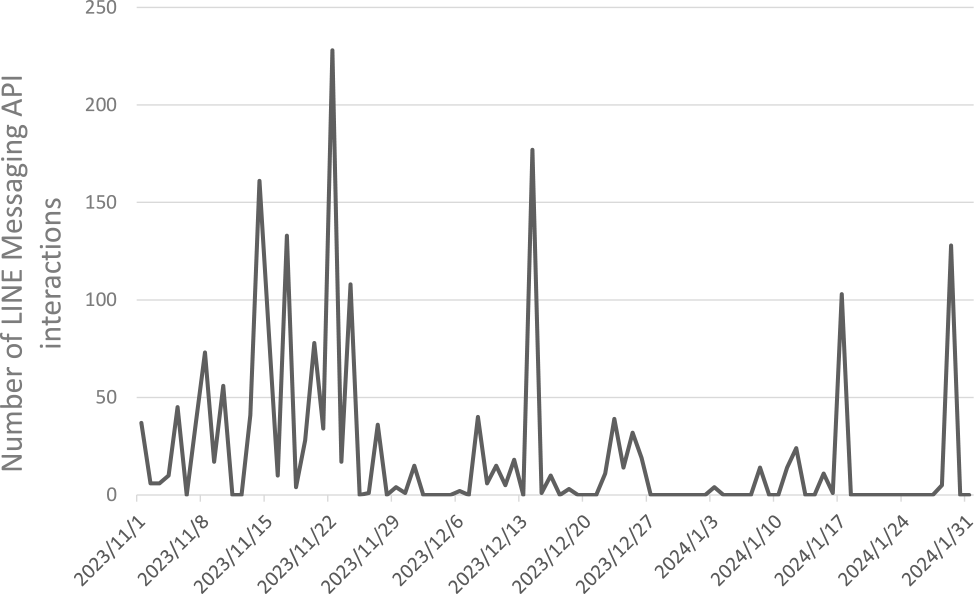
The usage data in Figure 12 provide important insights into how students interacted with the chatbot system. The average interaction count suggests that students engaged with the system multiple times, indicating that it was well-received and functioned effectively as a research information access tool.
The system's interactivity may have contributed to this positive engagement. Unlike static web pages, the chatbot allows users to access only the information they need through structured menu options. This access method likely improved communication efficiency. Moreover, the chatbot's conversational format helps deliver information in concise and manageable units, making it easier for students to absorb complex content.
Figure 12 shows clear peaks in usage on November 15 and 22, December 13, January 17, and January 31. These dates correspond to weekly laboratory sessions and end-of-semester events. This pattern suggests that the chatbot complemented traditional educational activities by providing timely access to relevant content.
The number of free-form feedback entries recorded in DynamoDB via the chatbot's evaluation function was 14. Based on this, we infer that the majority of messages were related to research introduction, quizzes, and external website link. Unfortunately, due to the lack of detailed logging for each function's activeness, it is not possible to determine the exact number of times each feature was utilized during the three months.
7.2.2 Scalability During Operation
During the three-month evaluation period, the system handled approximately 2,000 interactions without requiring manual scaling. Thanks to AWS's serverless architecture, including Lambda and API Gateway, the system automatically scaled to meet demand without performance degradation. This confirmed the scalability and reliability of our architecture under real-world usage conditions.
7.2.3 User Feedback
The evaluation focused on three qualitative criteria designed to assess the chatbot's performance:
- ・Clarity of Information: The degree to which the chatbot delivers clear and concise responses to user queries.
- ・Ease of Use: The overall usability of the chatbot interface, including how easily users can access features such as research content and quizzes.
- ・Engagement Level: The extent to which the chatbot encourages user interaction, particularly through features like quizzes and feedback submission.
We collected 14 free-form feedback comments from users via the chatbot's evaluation function. These comments covered all major functions: research introduction, quiz, external website link, and user evaluation. Table 1 presents the feedback results. Overall, users responded positively, especially regarding the research introduction feature, which was praised for providing detailed and helpful information about student projects.

To gain a clearer understanding of user perceptions, we categorized the 9 feedback comments in Table 1 according to the three qualitative criteria. Each comment was reviewed and assigned to one or more relevant categories. The distribution is as follows:
- ・Clarity of Information: 4 comments
- ・Ease of Use: 5 comments
- ・Engagement Level: 3 comments
Some comments addressed multiple criteria, reflecting overlapping user experiences. These findings suggest that users particularly appreciated the intuitive interface and the clarity of information provided by the chatbot. Engagement through interactive features such as the quiz was also viewed favorably. This quantitative analysis reinforces the conclusion that the system addressed key aspects of usability and engagement effectively. Further areas for improvement are discussed in the next subsection.
7.2.4 Adjusting Quiz Difficulty
First, the quiz difficulty was perceived as too high, with suggestions to provide different difficulty levels. To address this, we propose adding more questions and diversifying the content. Currently, questions are categorized into 2–3 genres per research area, but further differentiation by difficulty level is necessary. The improvements for quiz difficulty are as follows.
- ・Set different difficulty levels (e.g., beginner, intermediate, advanced) and allow users to choose quizzes according to their level.
- ・Add a function to change the difficulty level during the quiz.
- ・Develop an algorithm to dynamically adjust the difficulty of the quiz based on the user's answer history.
7.2.5 Ending the Quiz
Second, users found it difficult to finish the quiz. The current mechanism requires sending an arbitrary message to end the quiz, which is not intuitive. The improvements for ending quiz are as follows.
- ・Add a “Quit Quiz” button to each question's options to provide a more straightforward way to exit at any time.
- ・Add a function to automatically end the quiz if there is no user input for a certain period.
7.2.6 Feedback Submission to the Evaluation Function
Third, the feedback submission process for the evaluation function was deemed cumbersome due to the requirement of prefixing messages with “Evaluation:”. The improvement for user feedback are as follows.
- ・Implement buttons (e.g., star ratings, satisfaction level selection) for feedback submission, allowing users to send feedback with a single tap.
- ・Display a link to a feedback input form in the chatbot, allowing users to submit feedback through the form.
7.3 Social Impact of the Chatbot
The chatbot significantly enhanced information dissemination by increasing accessibility and interaction. Key outcomes include:
- ・Enhanced accessibility to research information, particularly for students.
- ・Positive contributions to educational support by providing engaging and interactive learning tools.
8. Conclusion
This paper presented the practical development and evaluation of a LINE chatbot integrated with AWS services, designed to enhance student access to laboratory research information. We adopted a user-centered approach supported by agile software development, serverless architecture, and iterative refinement based on user feedback.
Our chatbot implementation utilized the LINE Messaging API and key AWS services such as Lambda, API Gateway, S3, and DynamoDB. The system provided four main functions: research introduction, quiz, external website link, and user evaluation. These features were designed to be concise, interactive, and easily accessible through mobile devices.
The usability evaluation showed that the chatbot was well-received by students, especially for delivering concise research summaries. Usage data revealed engagement patterns aligned with academic schedules. Based on feedback, we identified areas for improvement, including quiz difficulty, session control, and feedback submission mechanisms.
To address these issues, future work will focus on expanding the content, refining user interactions, and implementing a flexible content management system. In addition, we plan to integrate the ChatGPT API to support more dynamic and context-aware responses, enabling the chatbot to answer complex queries and provide deeper explanations.
By continuously improving the design and functionality of our chatbot system, we aim to create a robust educational tool that not only disseminates information but also fosters student engagement, curiosity, and autonomous learning. We hope that our insights will inform readers the development of similar systems in educational and public service contexts.
Acknowledgments We would like to thank Riku Ishii and Ryo Aragane for their efforts to develop our LINE chatbot and a laboratory website.
References
- [1] IBM: 5 types of chatbot and how to choose the right one for your business (online), Retrieved from 〈https://www.ibm.com/think/topics/chatbot-types?mhq=chatbot&mhsrc=ibmsearch_a〉 (accessed 2025-01-21).
- [2] LY Corporation: Partnerships with Local Governments (online), Retrieved from 〈https://linecorp.com/en/csr/activity〉 (accessed 2024-09-03)
- [3] Hokkaido University of Science: Official Website (online), Retrieved from 〈https://www.hus.ac.jp/〉 (Accessed 2024-09-03)
- [4] Lokman, A. S., and Ameedeen, M. A.: Modern Chatbot Systems: A Technical Review, in Proceedings of the Future Technologies Conference (FTC) 2018, pp.1012–1023 (2018).
- [5] Adamopoulou, E. and Moussiades, L.: An Overview of Chatbot Technology, in Proceeding of Artificial Intelligence Applications and Innovations, AIAI 2020, pp.373–383 (2020).
- [6] Luo, B., Lau, R. Y. K., Li, C., and Si, Y.: A critical review of state-of-the-art chatbot designs and applications, in WIREs Data Mining and Knowledge Discovery, Vol.12, Issue 1, e1434 (2021).
- [7] Hangyo, M., Azuma, H., Kamiya, T., and Ohtake K.: ICT Applications in Disaster Response and Disaster Management Chatbot SOCDA, IEICE Communications Society Magazine, Vol.15, No.3, pp.200–210 (2021).
- [8] Noguchi, G., Yi Ng, K., Ueda, N., Norizoe, R., Shimada, A.: Development and Operation Results of a Learning Support System Using Chatbots Under COVID-19 Crisis at Kyushu University, Journal for Academic Computing and Networking, No.27, pp.22–28 (2023).
- [9] Suzuki, S., Yoshino, T.: Evaluation of a Class Support Chatbot to Encourage Students to Ask Questions, The Transactions of Human Interface Society, Vol.25, No.2, pp.77–88 (2023).
- [10] Heryandi, A.: Developing Chatbot For Academic Record Monitoring in Higher Education Institution, IOP Conference Series: Materials Science and Engineering Vol.879, pp.1–9 (2020).
- [11] Crowdstrike: Denial-of-Service (DoS) Attacks (online), Retrieved from 〈https://www.crowdstrike.com/cybersecurity-101/denial-of-service-dos-attacks/〉 (Accessed 2024-07-19)
- [12] Crowdstrike: What is a DDoS Attack? (online), Retrieved from 〈https://www.crowdstrike.com/cybersecurity-101/what-is-a-ddos-attack/〉 (Accessed 2024-07-19)
- [13] Darwish, M., Ouda, A., and Capretz, L. F.: Cloud-based DDoS Attacks and Defenses, Proc. IEEE International Conference on Information Society (i-Society 2013), pp.67–71 (2013).
- [14] Somani, G., Gaur, M. S., Sanghi, D., Conti, M., Buyya, R.: DDoS attacks in cloud computing: Issues, taxonomy, and future directions, Computer Communications, Vol.107, pp.30–48 (2017).
- [15] Rajan, A. P.: A review on serverless architectures - function as a service (FaaS) in cloud computing, Journal of the TELKOMNIKA Telecommunication, Computing, Electronics and Control, Vol.18, No.1, pp.530–537 (2020)
- [16] Amazon Web Services (online), Retrieved from 〈https://aws.amazon.com/〉 (Accessed 2024-10-10)
- [17] Google Cloud Platform (online), Retrieved from 〈https://cloud.google.com/〉 (Accessed 2024-10-10)
- [18] Microsoft Azure (online), Retrieved from 〈https://azure.microsoft.com/〉 (Accessed 2024-10-10)
- [19] LINE Developers: Messaging API (online), Retrieved from 〈https://developers.line.biz/en/services/messaging-api/〉 (Accessed 2024-09-03)
- [20] Sugio, N., Arasawa, K., Matsukawa, S., Suzuki, A., and Matsuzaki, H.: Development of a LINE Chatbot using Amazon Web Services, Proc. 6th International Conference on Engineering and Applied Sciences, TICEAS (2024).
- [21] Manifesto for Agile Software Development (online), Retrieved from 〈https://agilemanifesto.org/iso/en/manifesto.html〉 (Accessed 2024-10-10)
脚注
- *1 https://www.line.me/en/
- *2 https://httpd.apache.org/
- *3 https://nginx.org/
- *4 https://developers.line.biz/en/docs/messaging-api/check-webhook-error-statistics/

sugio-n@hus.ac.jp
Nobuyuki Sugio received his B.E., M.E., and Ph.D. degrees in all Engineering from the Tokyo University of Science in 2002, 2004, and 2017 respectively. He joined NTT DOCOMO INC. as a researcher in 2004. He was a member of Cryptographic Technology Promotion Committee from 2016 to 2021. Since 2021, he has been a faculty member of the Hokkaido University of Science. His current research field is cryptography, especially cryptanalysis for symmetric ciphers. He is a member of IEICE, IPSJ, and IEEJ.

Komei Arasawa received his B.E., M.E., and Ph.D. degrees in all Engineering from the Muroran Institute of Technology in 2016, 2018, and 2021 respectively. Since 2021, he has been a faculty member of the Hokkaido University of Science. His current research field is social computing. He is a member of IEICE and IPSJ.

Shun Matsukawa received his B.E., M.E., and Ph.D. degrees in all Engineering from the Muroran Institute of Technology in 2013, 2015, and 2018 respectively. Since 2021, he has been a faculty member of the Hokkaido University of Science. His current research field is data science. He is a member of IEICE, IPSJ, and ASJ.

Akihiro Suzuki received his B.E., M.E., and Ph.D. degrees in all Engineering from the Hokkaido Institute of Technology in 2007, 2009, and 2012 respectively. He joined Japan Technical Software INC. as an engineer in 2012. Since 2018, he has been a faculty member of the Hokkaido University of Science. His current research field is software engineering. He is a member of IEICE and SPM.

Hiroki Matsuzaki received his B.E., M.E., and Ph.D. degrees in all Engineering from the Hokkaido University in 1992, 1994, and 1997 respectively. He joined Hokkai-Gakuen University as a faculty member in 1998. Since 2008, he has been a faculty member of the Hokkaido University of Science. His current research field is acoustic phonetics. He is a member of IEICE, ASJ, JSLP, and ASA.
採録日 2025年5月20日